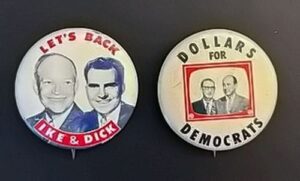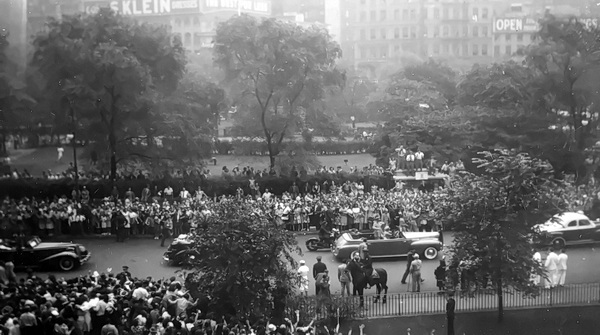 The 1950s belonged to the “Hero of D-Day,” General, then President Dwight David Eisenhower. “Ike” was unstoppable, first as head of the allied WWII armies and then as Commander in Chief during the beginning of the Cold War. However, a popular and academically minded Governor of Illinois, Adlai Stevenson, tried twice to unseat him. In 1956, still lagging in the polls, the Democrats held a televised fund-raising campaign. Donors received the button below as a “thank you.” Still, “Ike & Dick” bested Stevenson and Senator Estes Kefauver of Tennessee with a thorough thrashing. People happily “backed” Eisenhower and Nixon.
The 1950s belonged to the “Hero of D-Day,” General, then President Dwight David Eisenhower. “Ike” was unstoppable, first as head of the allied WWII armies and then as Commander in Chief during the beginning of the Cold War. However, a popular and academically minded Governor of Illinois, Adlai Stevenson, tried twice to unseat him. In 1956, still lagging in the polls, the Democrats held a televised fund-raising campaign. Donors received the button below as a “thank you.” Still, “Ike & Dick” bested Stevenson and Senator Estes Kefauver of Tennessee with a thorough thrashing. People happily “backed” Eisenhower and Nixon.
Background
Dwight D. Eisenhower (1890–1969) was the 34th President of the United States from 1953–1961 and a five-star general in the U.S. Army. He was born in Denison, Texas, the third of seven sons. His family moved to Abilene, Kansas, in 1892, which he considered his hometown. Early on, Eisenhower developed a strong interest in military history, as he was influenced by his mother’s collection of history books.
He attended the U.S. Military Academy at West Point, graduating in 1915. Eisenhower was stationed in the United States during World War I and, subsequently, did not see combat. He held various positions between the wars, including serving under General Douglas MacArthur in the Philippines.
During World War II, Eisenhower became the Supreme Commander of the Allied Expeditionary Force in Europe. He planned and executed the D-Day invasion in 1944, leading to the liberation of Western Europe from Nazi control.
As President, Eisenhower ended the Korean War through an armistice in 1953. His foreign policy focused on containing communism and supporting coups in Iran (1953) and Guatemala (1954) to install pro-American regimes. Domestically, he launched the Interstate Highway System in 1956, transforming American infrastructure.
Eisenhower’s presidency also addressed civil rights; in 1957, he sent federal troops to Little Rock, Arkansas, to enforce school desegregation. He was re-elected in 1956 and, in his 1961 farewell address, warned against the “military-industrial complex.” Eisenhower passed away in 1969, leaving a legacy as a military leader and President.
More Eisenhower History

This photo is a snapshot of history through the lens of photographer Joe Sachs. It notes the Eisenhower parade along Union Square in New York City on June 19, 1945, honoring his leadership as Supreme Commander of the Allied Expeditionary Force during World War II.
